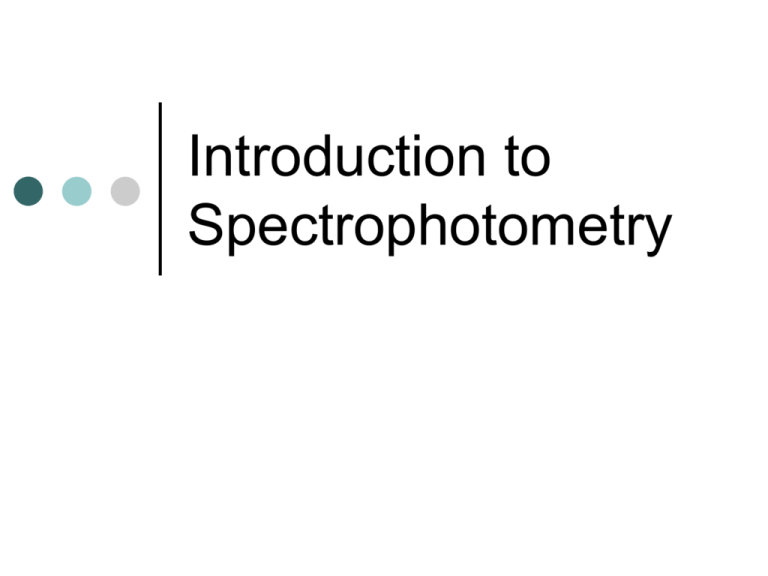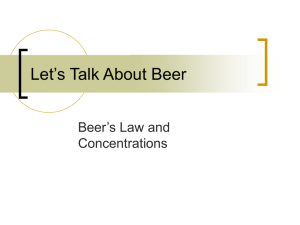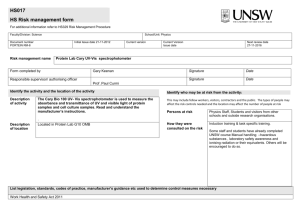absorbance.
advertisement

Introduction to Spectrophotometry Why Spectrophotometry? Imagine you are to make a 1μM solution of a specific protein that you believe could have anti-carcinogenic properties. Unfortunately if the protein is 100X more concentrated it has serious side effects. How could you be sure of the concentration? Why Spectrophotometry? A spectrophotometer or “spec” could be used to quantify the concentration of a solution. A spec shines a beam a light on a sample. The molecules in the sample either absorb light energy, reflect the light or the light transmits between the atoms and molecules of the sample. Spectrophotometry Overview The spec measures the amount of light transmitted through the sample or transmittance. Although the spec measures the percent of light transmitted (%T), by using an equation it can convert the transmittance data to absorbance. Absorbance or transmittance data can then be compared to known standard curves to quantify a sample. Spectrophotometry Overview Spectrophotometers shine either UV light, visible light or both on a sample. Depending on the sample, different parts of the EM spectrum are used. Physics Review Why do blue objects look blue? The object absorbs all other wavelengths of visible light except blue which is reflected. Visible, or white, light ranges from blues at 350 nm to red at 700 nm The different wavelengths of light also contain different amounts of energy. The spec detects the differences in energy Electromagnetic Spectrum How a Spec Works Features UV/VIS Specs contain two lamps Tungsten lamp – 350-700 nm Deuterium lamp – 200-350 nm Wide variety of other options Scanning • Time or wavelength Digital / graphic output One dial How a Spec Works Features Common features (Spec 20) Our spec (Spec 20) Lamp, prism or grating, sample holder, display, detector, and knob Knob rotates a prism which directs a different color through the sample Fancy specs have an automatic feature that scans for the maximum absorbance which then indicates the ideal wavelength for that sample How a Spec Works The wavelengths of light from tungsten lamp shine on a sample. The molecules in the sample either absorb or transmit the light energy of one wavelength or another. The detector measures the amount of light being transmitted by the sample. How a Spec Works The spec reports the value directly as (% transmittance) or converts it to the amount of light absorb in absorbance units (au). To convert between transmittance and au the spec uses an equation based on Beer’s Law. A=2-log10(%T) How a Spec Works Beer's law: the absorbance is directly proportional to the concentration of a solution. So, as absorbance of a sample increases, the transmittance decreases and vice versa. If molecules are not absorbing all the energy from a light beam, then the remaining light penetrates (transmits) through the sample. Beer’s Law Beer’s law is a relationship between the light absorbance of a substance and its concentration It is often written: A = a×b×c where: A = Absorbance of solution a = absorptivity, or how well the substance absorbs light b = path length, length of sample holder c = concentration of solution Beer’s Law Often a and b will not change in an experiment, we can combine them into a new constant, k. Thus: A = kc. Note that this is the equation of a straight line y = mx + b where y = A, x= c, m = k and b = 0. (Remember that m is the slope of the line, and b is the y-intercept.) Beer’s law then states that a plot of absorbance vs. concentration will give a straight line passing through the origin. Such a graph is labeled a Beer s Law Plot . The slope of the line is characteristic of and depends upon the solution used. How a Spec Works To be detected by a visible light spec, molecules must be colored or have a colored indicator added. starch & iodine protein and biuret’s solution Colorless molecules are not detected by a VIS spec since the do not absorb any wavelengths within the white light. How a Spec Works: A blue example Consider a blue solution When the white light shines on a blue molecule, all wavelength are absorbed except blue. The blue wavelengths are transmitted or reflected off the molecules. Some of these blue wavelengths hit the detector and blue light has a certain amount of energy. How a Spec Works: An example If the color of the solution is unknown, then all of the wavelengths could be measured and graphed. An absorbance spectrum is a graph that shows a samples at different wavelengths. The peaks on the spectrum would indicate the wavelength at which a molecule absorbs the most light is called lambamax. How a Spec Works: A “clear” example Molecules such as proteins and nucleic acids, DNA & RNA, are often the most important in biotech labs. When proteins and DNA are in solution they are “colorless” or do not absorb light in the visible light spectrum. In order to assay, measure, these solutions either a UV light needs to be used or an indicator is added to the solution. How a Spec Works: A “clear” example Proteins can be made visible by adding Bradford reagent or Biuret reagent. Diphenylamine (DPA) or ethidium bromide (EtBr) make nucleic acids visible. DPA turns DNA blue and RNA green EtBr interacts with DNA and UV light by glowing orange How a Spec Works Identification Certain molecules have known values for lambamax. This can be used to identify unknowns in a solution. Hemoglobin absorbs the most light at 395 nm, so any solution with a peak at 395 may indicate the possible presence of hemoglobin. How a Spec Works Concentration The concentration of a solution also affects the solution’s absorbance. If there are more molecules in one solution then another, then there are more molecules to absorb light. The amount of light that a sample absorbs indicates how many molecules (the concentration) are present. How a Spec Works Concentration If there are twice as many molecules in a solution, there would be twice as much absorbance. Likewise, half as many molecules absorb half as much light. On a plot of absorbance versus concentration, the resulting graph yields a straight line. The equation for the straight line (termed regression line) can be used to determine the concentration of an unknown solution once the %T has measured. How a Spec Works Concentration Some specs can monitor changes in samples over time. Enzyme studies are conducted by monitoring the change in a colored product over time. Review Questions What is measured in a spectrophotometer? What is the difference in a UV and VIS spec? What happens to the absorbance of a sample as the concentration of a sample increases or decreases? What color of light has a wavelength of 530 nm? If a molecule absorbs light at 530 nm, what color would it be? What color do we no it is not?






